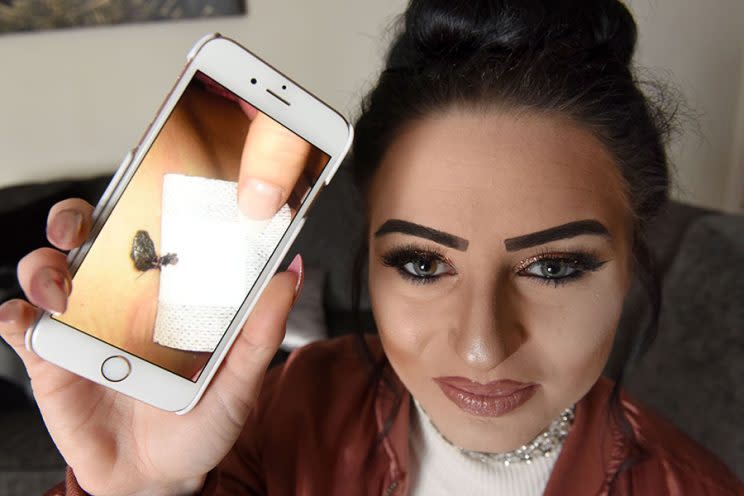This Young Woman Says Bikini Selfies Saved Her Life
A 21-year-old woman in the U.K. is crediting her selfie habit with saving her life.
Cloe Jordan told CATERS News that she first started paying closer attention to a mole on her stomach after she developed a bikini selfie habit. Jordan says that she felt her mole was “getting in the way” when she took pictures.
The mole, which she’d had all her life, was prominent, growing, and changing color, so she eventually decided to see a doctor about having it removed.
However, her doctor flagged the mole as potentially cancerous and, after tests, discovered that it was melanoma, the most deadly form of skin cancer. And, Jordan was told, her skin cancer might have spread.
“I had no idea my mole has turned cancerous. I’d had it all my life,” Jordan told CATERS News. “I loved going on holiday and being tanned, and although I didn’t regularly go on sun beds, I did go through a period of going on once or twice per month.”

Jordan said she felt “numb” after hearing her diagnosis: “I never imagined to get something so serious while being young, but I’m so thankful it was getting in the way of my bikini selfies now, as it has definitely saved my life.” Jordan had her mole removed and is waiting on having additional treatment. She’s been left with a sizable scar on her abdomen, because surgeons said the mole was deep into her skin, making the area that needed to be removed fairly large.
“I knew that if by sharing my experiences and it stopped one person going on sun beds it would be worthwhile,” she said. “I will never lay in the sun again and would much rather stick to a bottle of fake tan or have a spray tan than damage my skin.”
Rates of melanoma have been rising steadily in the U.S. for the past 30 years. According to the American Cancer Society, an estimated 87,110 new melanomas will be diagnosed this year, and nearly 10,000 people will die of the disease in 2017.

Gary Goldenberg, MD, medical director of the Dermatology Faculty Practice at the Icahn School of Medicine at Mount Sinai, tells Yahoo Beauty that it’s not unusual for a mole someone has had their whole life to turn cancerous — and sun or tanning bed exposure is often to blame.
That’s why Joshua Zeichner, MD, a New York City-based board-certified dermatologist, tells Yahoo Beauty that it’s important to keep tabs on your moles. “Take a look at yourself monthly in your birthday suit,” he says, adding that it’s not a bad idea to recruit a loved one to look at hard-to-see areas like your back. And don’t just look at your arms, trunk, and legs and call it a day. It’s also important to look at your genital area and between your fingers and toes, he says. You can follow the progress of your moles with selfies, like Jordan, or you can mentally keep track.

You’re looking for new or changing moles, as well as any that just look or feel different or start to bleed, Zeichner says. It’s also a good idea to know the ABCDE rules for skin cancer detection, he says: A stands for asymmetry, or one side of the mole looks different than the other side, B stands for border (harmless spots typically have a smooth border, while concerning ones may have a jagged edge), C stands for color (harmless moles typically are brown or light brown, while harmful ones can be different colors, including black, gray, blue, or white), D stands for diameter (any spot larger than the size of a pencil tip eraser should be evaluated), and E stands for evolution, i.e., whether a spot changes over time.
Keep this in mind too: Zeichner says that people rarely develop new moles after the age of 30, so if one suddenly crops up, it’s a good idea to flag it for your doctor. Goldenberg agrees. “New moles are concerning, especially after sun exposure,” he says. “In fact, 80 percent of melanomas are melanoma from the get-go and 20 percent arise from moles one already has. ”
And if you’re unsure whether a mole is iffy or not, talk to a professional — and don’t wait. “It may save your life,” Goldenberg says.
Read more from Yahoo Style + Beauty:
Young Women Know About Skin Cancer Risks — But They’re Still Using Tanning Beds
An Acne Makeup Tutorial Is Going Viral — and Setting Off a Debate
People Who Regularly Tan Are Likely to Have Other Addictions
Follow us on Instagram, Facebook, and Pinterest for nonstop inspiration delivered fresh to your feed, every day. For Twitter updates, please follow @YahooStyle and @YahooBeauty.

 Yahoo News
Yahoo News 